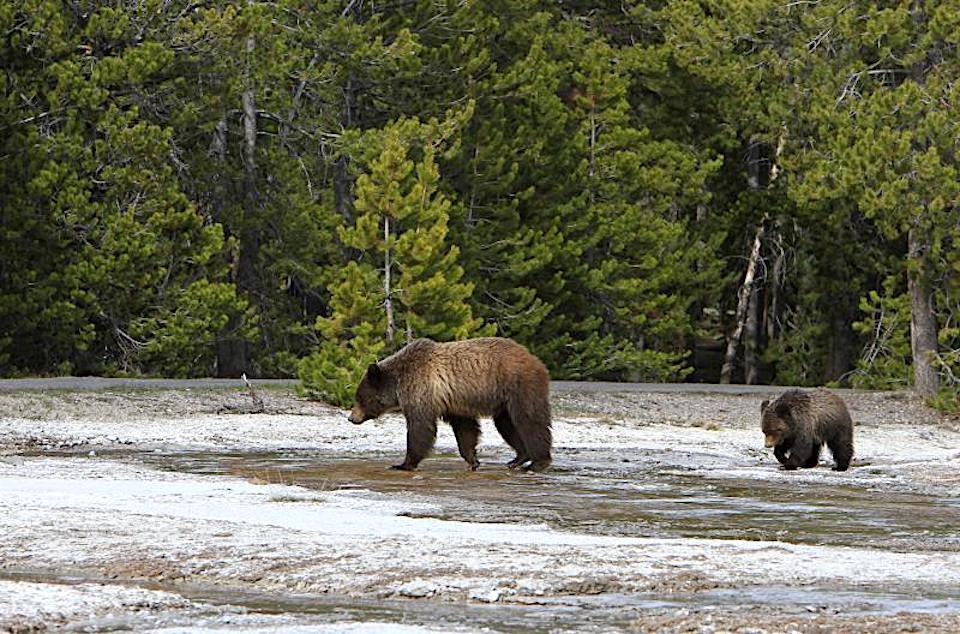
There's a move in the Wyoming Senate to relocate trapped grizzly bears from the Greater Yellowstone Ecosystem to California/NPS, Jim Peaco
April Fool's Day is still a couple months off, but a measure adopted in the Wyoming Senate the other week to send trapped grizzly bears to California does make one wonder how serious the chamber is.
Earlier in my career I spent nine years covering the Wyoming Legislature, and every now and then an oddball measure would surface. This amendment, introduced by state Sen. Larry Hicks, fits that description. Hicks views his proposal as a way to deal with troublesome grizzly bears that otherwise would be euthanized.
Grizzly bears are trapped and relocated in Wyoming and in some cases are euthanized for livestock depredation, property damage or endangerment of human life. If it determines under the laws of the state of Wyoming that extraterritorial relocation would be beneficial for managing Wyoming's wildlife and protecting Wyoming workers and other citizens and tourists of the state, the game and fish commission may relocate to the state of California all grizzly bears trapped for relocation or that would otherwise be euthanized.
The amendment was tacked onto a Senate bill that authorizes the Wyoming Game and Fish Commission to establish a hunting season for grizzly bears in the Greater Yellowstone Ecosystem, which includes Yellowstone and Grand Teton national parks. Whether it makes it through the legislative session and is signed into law by the governor remains to be seen. Of course, the bill, if enacted, could run into conflict with the bear's current status as threatened with extinction in the ecosystem.
Last September grizzly bears that roam the Greater Yellowstone Ecosystem regained protection from hunters under the Endangered Species Act due to a judge's ruling that the U.S. Fish and Wildlife Service did not adequately consider how delisting the bears would impact the species as a whole. That ruling brought a halt to planned grizzly bear hunts in Wyoming and Idaho.
How did Hicks settle on California for the bears' destination? The bear on that state's flag.
“I think it’s only fitting and right that we help our friends out to the West to help restore their state emblem,” Hicks said in a Jackson Hole News and Guide story. “This is the first step in getting there.”



Comments
Karla, the facts stand up in the story. To that point, grizzlies in the Greater Yellowstone Ecosystem regained threatened status under the Endangered Species List last fall when a judge overturned the delisting. See the link in the story.
You are correct Rick, it is unlikely they could enforce this on Federal lands but the legislation doesn't seem to be specific to Federal lands.
EC, going back to your original question, I do think there would be some rather large logistical problems with the senator's proposal, even if the ESA wasn't one of them.
1) Getting California's buy-in, which seems questionable.
2) Actually transporting the bears from site of capture to California. Would sedatives be employed, and if so, you'd probably need constant monitoring.
3) Timing. Would Wyoming have a team in place whenever a bear is trapped to transport it to California, or would it have to stage one after capture and how long might that take?
3) On California's end, I presume you'd need a release team there to meet the Wyoming team. Where would you release them? National forests? National parks? State lands? BLM? Again, more red tape.
4) You'd probably need U.S. Fish and Wildlife Service approval to transport the bears across state lines.
5) While it's possible/likely that grizzlies could/will again be delisted in the Greater Yellowstone Ecosystem, I believe they would still be listed as threatened in California, so more red tape to navigate.
6) If all of the above were accomplished, how many bears are we talking about? Would it be cost effective? Who would bear the cost?
Going back to Karla's comments, for many, many years it has been recommended to hike with bear spray in grizzly bear habitat in Wyoming. It's not a recent development. At the same time, I've been hiking/backpacking/camping in Yellowstone --theoretically the core of the ecosystem's grizzly population -- for more than 30 years, always with bear spray, and have never encountered a grizzly close enough to require its use. What has changed over that time is developmental sprawl in the ecosystem and bear dispersal, so I don't question her comment about seeing more bears.
All that said, all things being equal -- grizzlies delisted, no lawsuits pending, everyone on board with the approach to managing the bear's populations -- I personally am not opposed to a hunting season, or a trap-and-relocate program if it makes sense. I'm not sure the senator's proposal passes the test at this point.
Bears are relocated all the time. Other than getting CA buy in, I don't see how crossing a state line complicates the process.
When was the last time an ESA-listed grizzly bear was relocated? Or even one not covered by the ESA?
ecbuck, the moving of animals across state lines is actually the perview of the USDA. You need an APHIS (guessing on the acronym there, used to work on the system years ago) permit to move the animal. This kind of permit applies to a lot of animals, so it's not a big deal, but it is red tape.
Also how many attacks have there been outside the park anyway? I know there has been an increase in the park in recent years, but many, according to locals anyway, were the stupidity of the tourists.
Many Californians would love to see the grizzly return, and there is ample habitat, but I doubt the politicians would be courageous enough to allow it. Then again, gray wolves have returned to California on their own, so....
Kurt, I don't know the answer to that but whether it is a black bear or an ESA grizzley doesn't make any difference on your list of objections.